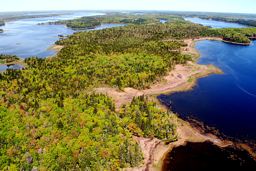 Tusket Islands Wilderness Area protects a mix of saltmarshes, headlands and islands scattered across the coastal waters near the mouth of Tusket River.
Tusket Islands Wilderness Area protects a mix of saltmarshes, headlands and islands scattered across the coastal waters near the mouth of Tusket River.
It includes small, representative examples of the biologically-rich and productive Tusket Islands natural landscape, and helps fill a significant gap in the provincial protected areas network.
Saltmarshes are an important feature of this area. They are one of Nova Scotia’s most threatened ecosystems, having been dyked and drained for agriculture since the 1700s. Provincially significant saltmarshes in this wilderness occur near Wedgeport, Abrams River and on Morris Island. These harbour over a dozen species of rare sedges, rushes, and other flora. A rich assemblage of waterfowl and shorebirds use them for breeding, resting and refueling during migration, or overwintering. Saltmarshes also contribute to the productivity of the marine ecosystem by providing habitat for the juvenile stages of many fish species.
The wilderness area protects seven small islands that provide important habitat for waterfowl and shorebirds year-round, and play a unique role as breeding sites for colonial seabirds such as terns and eiders.
The diverse scenery and wildlife of the Tusket Islands attracts boaters, sea kayakers, and campers. The area is popular for hunting, clam digging and other activities.
Portions of the wilderness area were acquired through a partnership with Ducks Unlimited, which has consented to designation of these lands as wilderness area.
A power line corridor crosses a portion of the wilderness area on Inner Spectacle Island. An existing license which Nova Scotia Power Inc. (NSPI) holds with Nova Scotia Environment will be amended to provide for its ongoing operation and maintenance.

